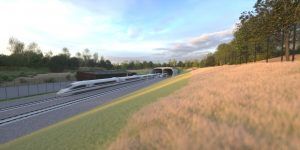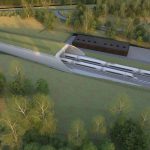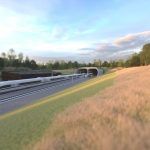 HS2 has unveiled the first images of the longest of three innovative green tunnels that will be built across Buckinghamshire and Northamptonshire to help blend the new high-speed rail line into the landscape and reduce disruption for residents.
HS2 has unveiled the first images of the longest of three innovative green tunnels that will be built across Buckinghamshire and Northamptonshire to help blend the new high-speed rail line into the landscape and reduce disruption for residents.
The 2.4 km (1.5 miles) long Greatworth tunnel will be built in a factory in Derbyshire before being shipped to site and assembled over the railway line as it passes the village. It will then be covered with earth and landscaped to fit into the surrounding countryside.
Applying lessons from the construction of the latest French high-speed lines, an off site modular approach was developed by HS2’s main works contractor, EKFB, a team made up of Eiffage, Kier, Ferrovial Construction and BAM Nuttall.
“The Greatworth green tunnel is a great example of what we’re doing to blend the new railway into the landscape and protect communities living close to the line. By adopting an ‘off site’ approach to manufacturing, we’re also cutting embedded carbon from the design, improving efficiency, safety and making the whole construction process less disruptive for the community,” HS2 Ltd’s Project Client Rohan Perin, said.
Designed as an ‘m’ shaped double arch, the tunnel will have two separate halves for southbound and northbound trains. Instead of the whole tunnel being cast on site, 5 different concrete precast segments will be slotted together to achieve the double arch, one central pier, two side walls and two roof slabs. All 5,400 segments installed at Greatworth will be steel reinforced, with the largest weighing up to 43 tonnes.
Concrete and steel are some of the biggest sources of carbon emissions within the construction industry and by reducing the amount of both materials needed for the tunnel, this lighter-weight modular approach is expected to more than halve the amount of carbon embedded in the structure. It also requires less people and equipment on site, improving safety and reducing disruption for residents.
Similar innovative green tunnels will also be built near Wendover in Buckinghamshire and Chipping Warden in Northamptonshire, stretching for a combined total of 6.4 km (4 miles). The tunnels will all have specially designed ‘porous portals’ at either end to reduce the noise of trains entering and exiting the tunnel and small portal buildings to house safety and electrical equipment.
Thousands of tonnes of rock and earth will be excavated during the initial stages of construction. These will be carefully separated and stockpiled on site for reuse later in the process, helping to keep trucks off local roads.
Tailored landscaping design plans will be developed for each tunnel, with thousands of native trees and shrubs typical to the local area, such as, Silver Birch, Oak, Beech and Willow planted to create new woodland areas around the portals and recreate the hedgerows and field boundaries on top of the tunnel.
The 13,290 segments for the three green tunnels are made by Stanton Precast at its Ilkeston factory.
Share on:






